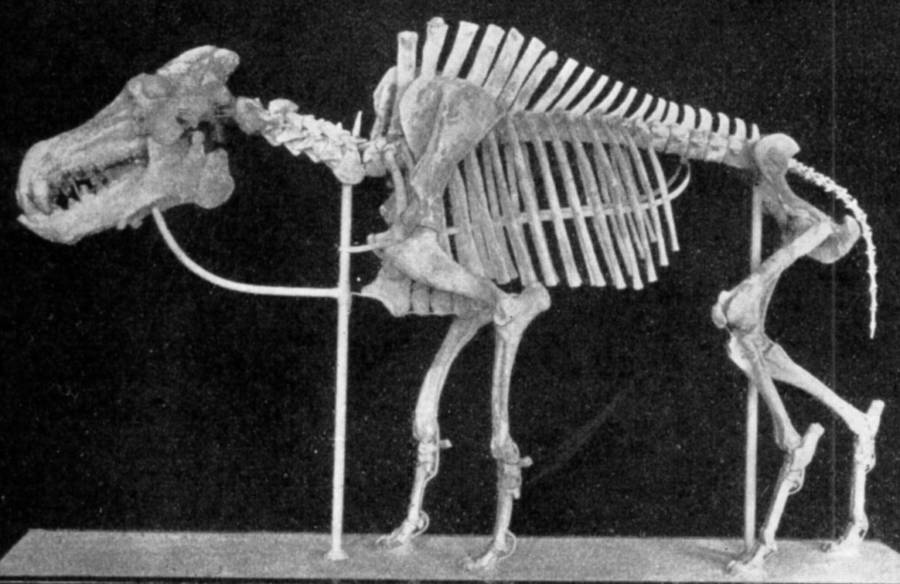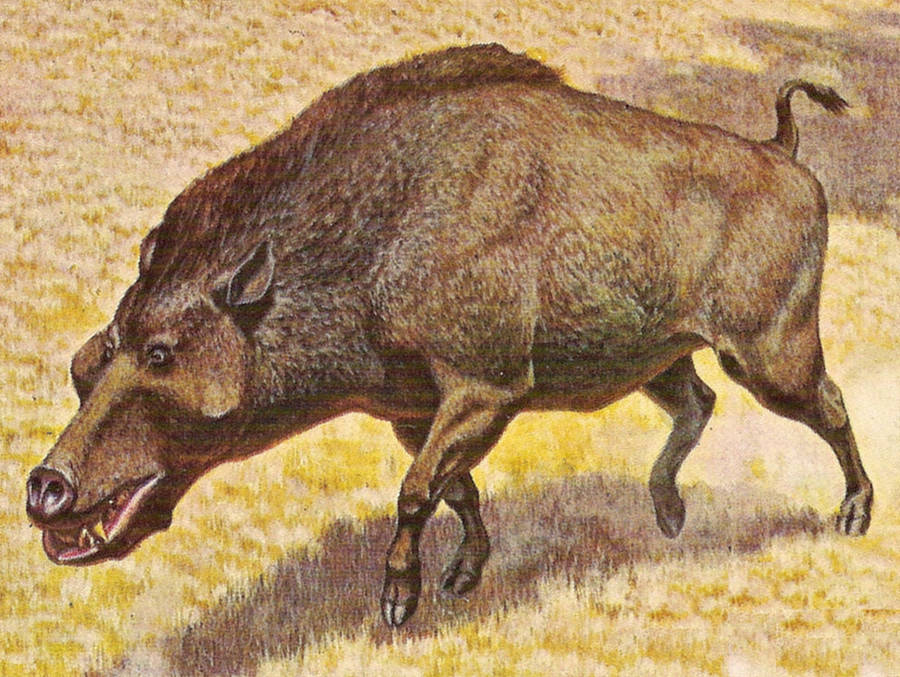Weighing in at 2,000 pounds and sporting arm-sized fangs, the entelodont earned its status as the "hell pig" of prehistoric North America.

Wikimedia CommonsA fossil of the Daeodon, the largest variant of entelodont or “Hell Pig.”
You’ve likely never heard of an entelodont, an extinct species seemingly summoned from the depths of hell. Indeed, the extinct creature is commonly referred to as a “hell pig” — and with good reason.
The species had the long wide jaw of a crocodile replete with a mouth full of teeth. It had a face studded with thick bones for protection in a fight and a stocky frame often rounded into a hump — not to mention demonic cloven hooves. The largest genus of entelodont, known as the Daeodon, could grow up to 2,000 pounds. Aptly named, Daeodon comes from the Greek word <daiso, for “hostile” or “dreadful.”
Despite their nickname, “hell pig,” the entelodont has no relation to modern pigs as evolutionarily, they’re closer to hippos or whales.
Not that this makes their appearance any less fearsome.
Roaming Grounds Of The Entelodont

Wikimedia CommonsA depiction of the terrifying entelodont.
Today, the entelodont live only in nightmares. The terrifying beasts went extinct between 19 and 16 million years ago. Originating in Mongolia in the middle Eocene epoch, these hell pigs spread to Europe and even to North America and existed for nearly 30 million years.
Paleontologists have uncovered fossils from one of the largest breeds of entelodont, called Dinohyus or Daeodon, in Nebraska, with other fossils having been discovered in central states like South Dakota and Wyoming. It is believed the roaming hell pig likely enjoyed floodplains and woodlands.
The fossils look just like the bones of an enormous dinosaur. The skeleton has huge teeth, a long snout, and deep-set eyes. In some cases, the head of the hell pig took up 35 to 45 percent of the creature’s total body mass and it’s believed that a hell pig could put another’s head directly into its mouth during a fight.
Even the smallest entelodonts were likely the size of an adult male deer and the largest rivaled a Clydesdale horse. The entelodont was the largest species to live in North America since the dinosaurs.
Daeodon: The Devil Among Demons

Wikimedia CommonsDaeodon, the largest of the hell pigs, easily dominated their environment.
With their long snouts full of teeth, enormous body mass and cloven hooves, an entelodont appeared to be ascended from hell itself. But the largest species of the entelodont is even more nightmarish: meet the Daeodon, whose name roughly translates to “hostile” and “tooth.”
“Hostile teeth” is an apt name for the Daeodon: it looks like the first — and possibly the last — thing anyone who crossed its path would see. This would be true if the Daeodon was perhaps not the passive giant paleontologists believe it to have been.
Though their massive jaws bragged an enormous set of sharp teeth in the front — some the size of a man’s wrist — the back molars were flat, which suggests that these demonic ancient beings may not have been fearsome predators at all. Using their sharp front teeth, they could easily tear flesh from bone and their strong back teeth could chew plant material. But they may have also used their powerful canines to dig for roots and not bone.
Indeed, whatever meat they did scrounge on they likely picked off of carcasses they themselves hadn’t killed.
The Powerful And Patient Hell Pig

Wikimedia CommonsHow the hell pigs may have looked in their natural habitat many millions of years ago.
Although the hell pigs had their gargantuan size and terrifying fangs at their disposal, it’s unclear whether or not they actively preyed on other animals. Bite marks matching the entelodont’s massive teeth have been found on the skulls of other animals.
This discovery either meant that the hell pigs used their superior strength to crush their the head of their prey (most predators would focus on a fleshier part to take down their meal) or that they intimidated these animals to scavenge their kills after the fact.
In fact, the Daeodon may have employed a cunning strategy to find dinner: wait for a predator to kill and then use their impressive size and strength to scare it away. Zigzag paths discovered by paleontologists suggest that when the hell pigs began to track down their next meal, they did not run toward it. This suggests that their strategy did not rely on a pursuit but on patience.
Although the entelodont likely wasn’t particularly bright, they did have a strong sense of smell.
Even though these “hell pigs” shared some characteristics with modern pigs, these creatures are a far cry from the plump pink pigs of today. Like pigs, entelodonts were omnivorous scavengers who ate whatever they could find including leaves, fruit, or other animals and eggs.
A Life Without Enemies
It seems that, for most of their existence, the entelodont had few enemies. Perhaps their enormous size and dreadful teeth intimidated other animals.
In any case, it seems that most conflicts did not occur between entelodont and other species. Rather, evidence in the form of large scars, centimeters deep in the bones of entelodonts, suggests that fights often occurred between the hell pigs themselves.

Wikimedia CommonsThe entelodont’s huge frame and enormous teeth helped it to intimidate prey.
Certainly, it doesn’t seem like the entelodont scared easily. Their huge teeth left evidence of their bravado on animals of all sizes. Evidence of Daeodon bite marks has even been found on rhinos.
Hyaenodon, a common predator of the era that looked like a mix between a hyena and a wild dog, stood only a meter tall. An entelodont, at its largest, had twice the body mass. It does not appear that the Hyaenodon hunted the entelodont, but it is possible that the entelodont waited for the Hyaenodon to kill, and then scared it away.
The entelodont was a huge, terrifying beast with few enemies and an undiscerning diet. So how did they go extinct?
The Extinction Of The Entelodont
The exact answer is unknown. However, several working theories suggest that a changing climate and the emergence of a new species may have played a role in their disappearance.
As the climate cooled, the types of plants available to the Daeodon’s diet changed. As thick forests transformed into grassy fields, it’s possible that the entelodont could not adapt.
In addition, although the hell pigs could run fast short distances, evolution gifted other grass-eating mammals with longer legs. This meant that the entelodont could not pursue other animals as effectively. Other species could travel faster for longer which gave them access to more food than the entelodont.
Towards the end of their existence, larger more vicious animals appeared in North America. Bear-dogs likely crossed over from Eurasia using the Bering Land Bridge. Saber-toothed cats also began to appear. Both predators were faster and fiercer than Daeodon.
This put the hell pigs’ survival at serious risk. The bear-dogs, in particular, proved to be a fatal threat. Their pack mentality meant that the entelodont could not intimidate them or chase them away from a fresh kill.
Although the entelodont evolved to survive the new climate by growing larger, shifts in weather patterns and food supplies favored other species like the bear-dogs instead.
A changing world left behind the powerful, slow-moving entelodont. Today, they exist only as fossils displayed in museums.
After this look at the mythic though very real Daedon, read about the four-legged whale that once lived near Peru, or learn about a 2,000-year-old tattoo gun discovered in Utah.





